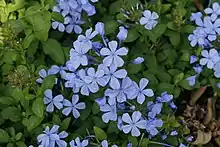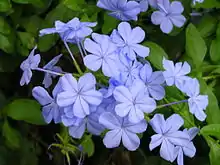Plumbago auriculata
Plumbago auriculata, the cape leadwort,[2] blue plumbago or Cape plumbago, is a species of flowering plant in the family Plumbaginaceae, native to South Africa.[3][4]
| Plumbago auriculata | |
|---|---|
 | |
| Plumbago auriculata | |
| Scientific classification | |
| Kingdom: | Plantae |
| Clade: | Tracheophytes |
| Clade: | Angiosperms |
| Clade: | Eudicots |
| Order: | Caryophyllales |
| Family: | Plumbaginaceae |
| Genus: | Plumbago |
| Species: | P. auriculata |
| Binomial name | |
| Plumbago auriculata | |
| Synonyms[1] | |
| |

The specific epithet auriculata means "with ears", referring to the shape of the leaves.[5]
Description
Plumbago auriculata is an evergreen shrub, often grown as a climber, ascending rapidly to 6 m (20 ft) tall by 3 m (10 ft) wide in nature, though much smaller when cultivated as a houseplant.[6] The leaves are a glossy green and grow to 5 cm (2 in) long.[3][4] The stems are long, thin, and climbing. The leaves alternate and are 2-5 cm while the five petals are about 2 cm wide and can be pale blue, blue or violet in color. There also variations with white (P. auriculata var. alba) or deep blue (P. auriculata 'Royal Cape') flowers. The flowers are arranged in a corymb-like and raceme inflorescence.[7] The flower of this plant is complete and perfect. The sepals and petals are connate while the pistil is adnate. The ovary of the flower is superior and the flower has regular symmetry. It has basal placentation, with 1 locule and 5 carpels.
Phytochemistry
Many secondary metabolites have been discovered and isolated from Plumbago auriculata such as plumbagin and palmitic acids.[8]
Cultivation
In temperate regions it may be grown outside in frost free areas, otherwise under glass. It grows best in full sun to part shade.
The species[2] and the white-flowered form P. auriculata f. alba[9] have both gained the Royal Horticultural Society's Award of Garden Merit.[10]
Plumbago auriculata can be propagated sexually by seeds and asexually by cutting in summer. It needs well-aerated soil and light and prefers acidic soil.
 Petals
Petals Petals
Petals Anther
Anther Ovary parts
Ovary parts Style
Style Sepals
Sepals
References
- "Plumbago auriculata". The Plant List. Retrieved 2018-01-27.
- "RHS Plant Selector - Plumbago auriculata". Retrieved 23 February 2020.
- "Botanica. The Illustrated AZ of over 10000 garden plants and how to cultivate them", p 691. Könemann, 2004. ISBN 3-8331-1253-0
- Nico Vermeulen:"The Complete Encyclopedia of Container Plants", p. 216. Rebo International, Netherlands, 1998. ISBN 90-366-1584-4
- Harrison, Lorraine (2012). RHS Latin for gardeners. United Kingdom: Mitchell Beazley. p. 224. ISBN 9781845337315.
- RHS A-Z encyclopedia of garden plants. United Kingdom: Dorling Kindersley. 2008. p. 1136. ISBN 978-1405332965.
- https://plantdatabase.kpu.ca/plant/plantDetail/1365
- de Paiva, Selma Ribeiro; Figueiredo, Maria Raquel; Kaplan, Maria Auxiliadora Coelho (2005-07-01). "Isolation of secondary metabolites from roots of Plumbago auriculata Lam. by countercurrent chromatography". Phytochemical Analysis. 16 (4): 278–281. doi:10.1002/pca.841. ISSN 1099-1565. PMID 16042155.
- "RHS Plant Selector - Plumbago auriculata f. alba". Retrieved 23 February 2020.
- "AGM Plants - Ornamental" (PDF). Royal Horticultural Society. July 2017. p. 80. Retrieved 7 May 2018.
| Wikimedia Commons has media related to Plumbago auriculata. |